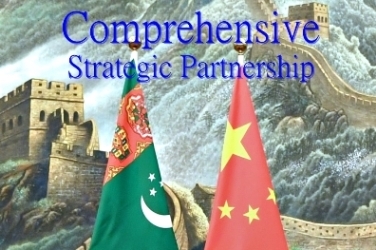nCa Analysis
Comprehensive Strategic Partnership was the main outcome of the visit of President Serdar Berdimuhamedov of Turkmenistan to China, 5-6 January 2023.
This has added plenty of new content to the already impressive partnership between the two countries.
There is the need to look at the nature of this freshly created Comprehensive Strategic Partnership and the range of possibilities it has created.
For starters, we should note that in the state relations the definition of strategic partnership (SP) or comprehensive partnership (CSP) is entirely up to the nations entering into this arrangement – there is no rigidly defined explanation of CSP or SP.
Moreover, in the modern history of the late 20th century, it was China that started popularizing the mechanism of strategic partnership in its various forms. The first strategic partnership of China was established in 1993 with Brazil.
Although the interpretation of the nature and extent of partnership is the prerogative of the signing parties, China has a fairly structured system of partnerships.
Quan Li, Wuhan University, Wuhan, China, and Min Ye Department of Politics, Coastal Carolina University, Conway, South Carolina, USA, have jointly written a paper titled: China’s emerging partnership network: what, who, where, when and why.
The paper is downloadable from this link:
According to them, in the dozens of partnership arrangements around the world, China has used a number of titles:
Partnership title
- Comprehensive Strategic Partnership of Coordination
- All-weather Strategic Cooperative Partnership
- All-round Strategic Partnership
- Global Comprehensive Strategic Partnership for the 21st Century
- Comprehensive Strategic Cooperative Partnership
- Comprehensive Strategic Partnership
- Mutually Beneficial Strategic Partnership
- Innovative Strategic Partnership
- Strategic Partnership of Coordination
- Strategic Cooperative Partnership
- Strategic Partnership
- Strategic Cooperation
- Closer Developmental Partnership
- All-round Partnership of Friendship and Cooperation
- Comprehensive Partnership of Friendship and Cooperation
- All-round Partnership of Cooperation
- Comprehensive Cooperative Partnership/Comprehensive Partnership of
- Cooperation
- Important Cooperative Partnership
- Partnership of Friendship and Cooperation/Friendly and Cooperative Partnership/Friendly Cooperative Partnership
- Partnership of Friendship/Friendly Partnership for Common Development
- Long-term Friendly and Cooperative partnership
- Comprehensive Cooperation
- Partnership of good Neighborliness and Mutual Trust
- New Partnership
The key word in several of these titles are ‘strategic’ and ‘comprehensive.’
Quan Li and Min Ye, in their paper noted above have offered the meaning of ‘strategic’ and ‘comprehensive’ from the point of view of China.
They write:
“The most authoritative explanation offered so far comes from China’s former Premier Wen Jiabao. He delivered a keynote speech in 2004 when visiting the European Union at Brussels, in which he elaborated that the term “comprehensive” refers to cooperation in the economic, technological, cultural and political fields; the relationship is both bilateral and multilateral, meaning that the dyadic countries in a comprehensive partnership may also work together in dealing with multilateral issues; a comprehensive relationship is multi-layer as well, including both government-to-government cooperation and people-to-people diplomacy.
“The term “strategic” means that cooperation between the two countries not only has an overall importance to the bilateral relationship but also is stable and long-term, overcoming the differences in ideology and political systems. Finally, the term “partnership” means that the two countries cooperate on the basis of mutual-respect, mutual-trust and equality. Both sides strive to develop a win–win relationship that is mutually beneficial.”
| Partnership title | Countries |
| Comprehensive Strategic Partnership of Coordination | Russia
|
| All-weather Strategic Cooperative Partnership | Pakistan
|
| All-round Strategic Partnership | Germany
|
| Global Comprehensive Strategic Partnership for the 21st Century | Great Britain
|
| Comprehensive Strategic Cooperative Partnership | Belarus, Cambodia, Chile, Myanmar, R. of Congo, Thailand, Vietnam |
| Comprehensive Strategic Partnership | Algeria, Argentina, Australia, Brazil, Ecuador,
Egypt, France, Greece, Indonesia, Iran, Italy, Malaysia, Mexico, New Zealand, Peru, Poland, Portugal, Saudi Arabia, Serbia, South Africa, Spain, Uzbekistan, Venezuela, EU |
| Mutually Beneficial Strategic Partnership | Denmark, Ireland |
| Innovative Strategic Partnership | Switzerland |
| Strategic Partnership of Coordination | Russia in 1996 |
| Strategic Cooperative Partnership | Afghanistan, Bangladesh, South Korea, Sri Lanka |
| Strategic Partnership | Angola, Canada, Costa Rica, Czechia, Fiji, Iraq,
Jordan, Kazakhstan, Kyrgyz, Mongolia, Nigeria, Qatar, Sudan, Tajikistan, Turkmenistan, UAE, Ukraine, Africa Union, ASEAN |
This is not a complete list. There are several more countries that are in partnership arrangements with China.
The paper of Quan Li and Min Ye was published in May 2019. Since then, some of these partnerships have been upgraded.
* * *
Comprehensive Strategic Partnership (CSP) is the framework for providing deeper and broader cooperation, using not only the present but also future opportunities.
This needs some explanation.
CSP is almost always the upgraded version of SP (Strategic Partnership). It can take several forms, such as between two countries, within a group of countries, or between a country and a group of countries.
It serves two main purposes: 1. Use of opportunities that have arisen as a result of fruitful SP; and 2. Creation of new opportunities by bringing institutions, organizations etc. so close that hive-mind phenomenon triggers itself. — This is what one comprehends by looking at SPs that have been elevated to CSP.
* * *
Elevation of Turkmenistan-China relations to the level of CSP has brought plenty of new content to the partnership.
To understand this, one needs to look at the following elements:
- Content of summit talks between the two presidents
- Joint statement issued by the two presidents
- List of documents signed
- Article written by President Serdar Berdimuhamedov for People’s Daily of China just before the start of his visit
/// nCa, 9 January 2023
To be continued . . .
